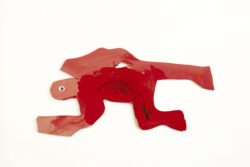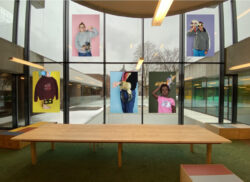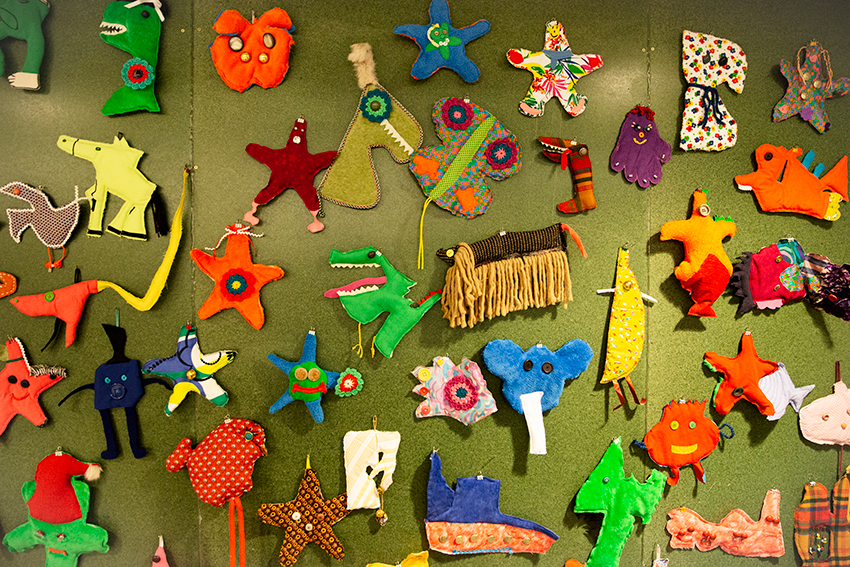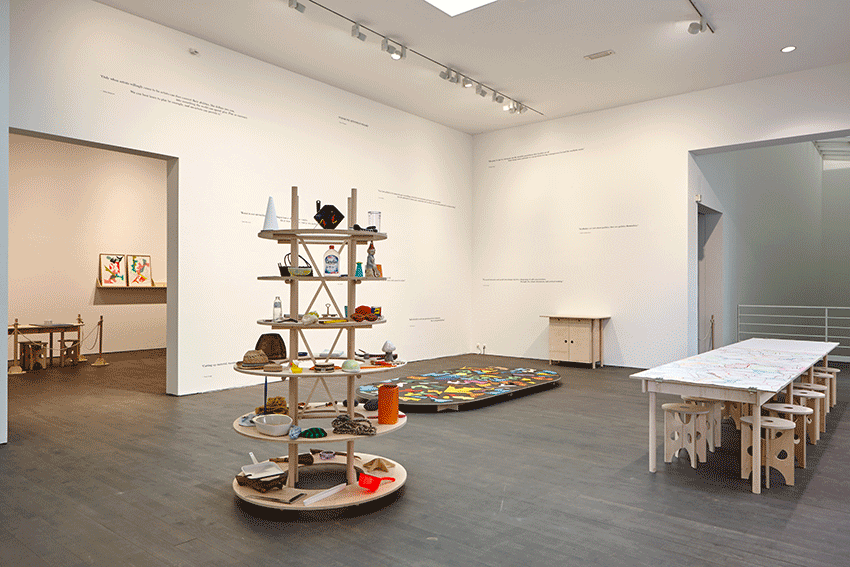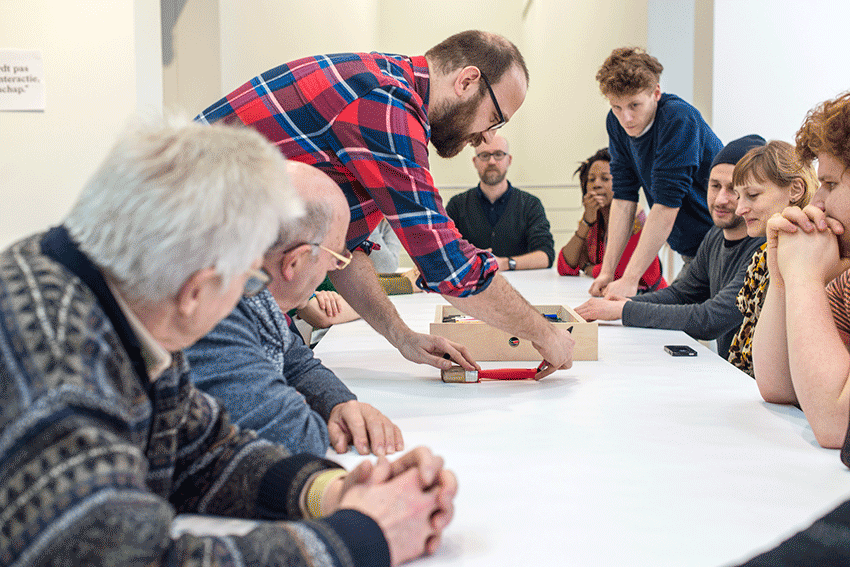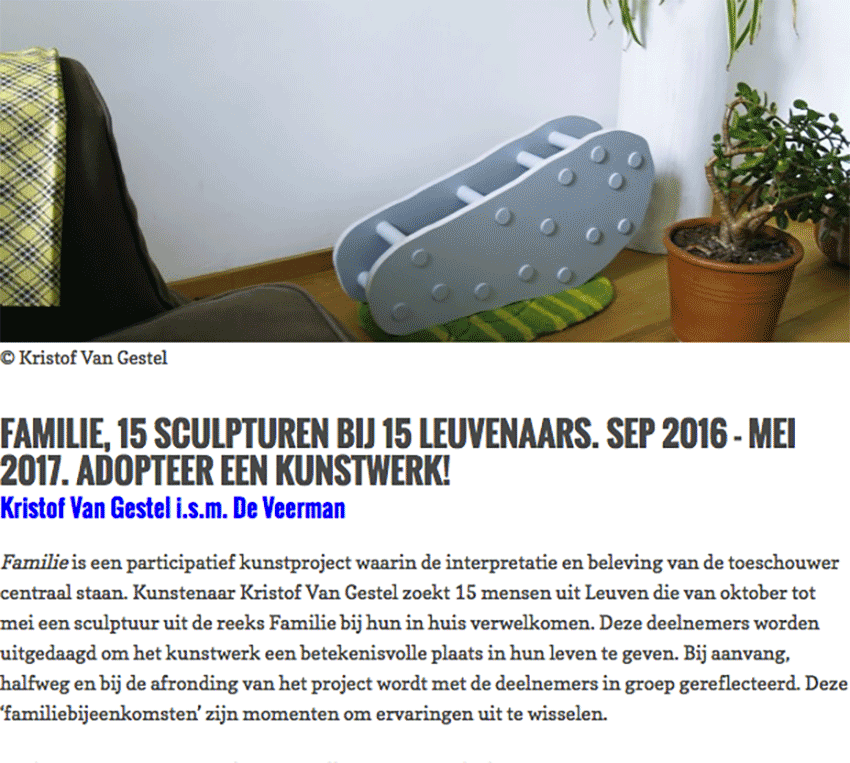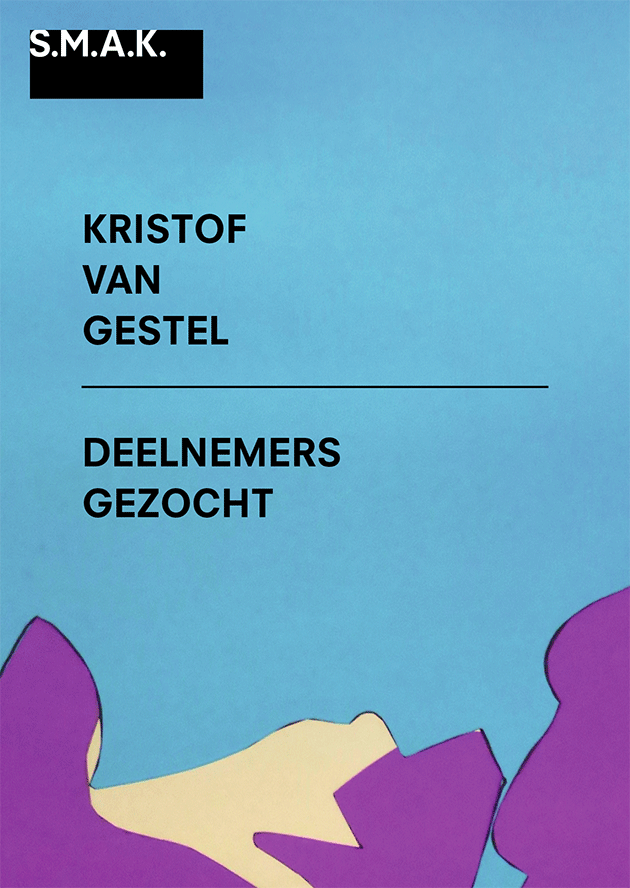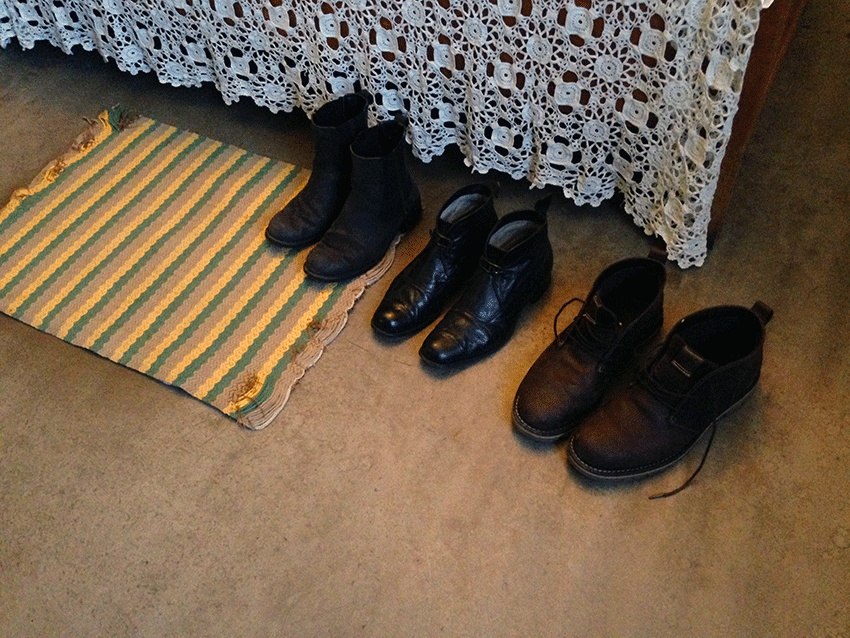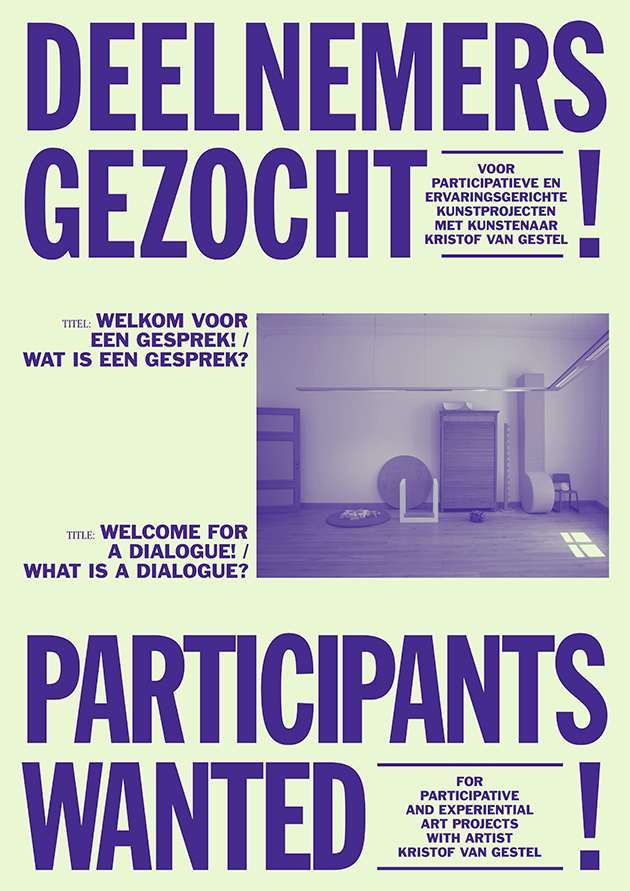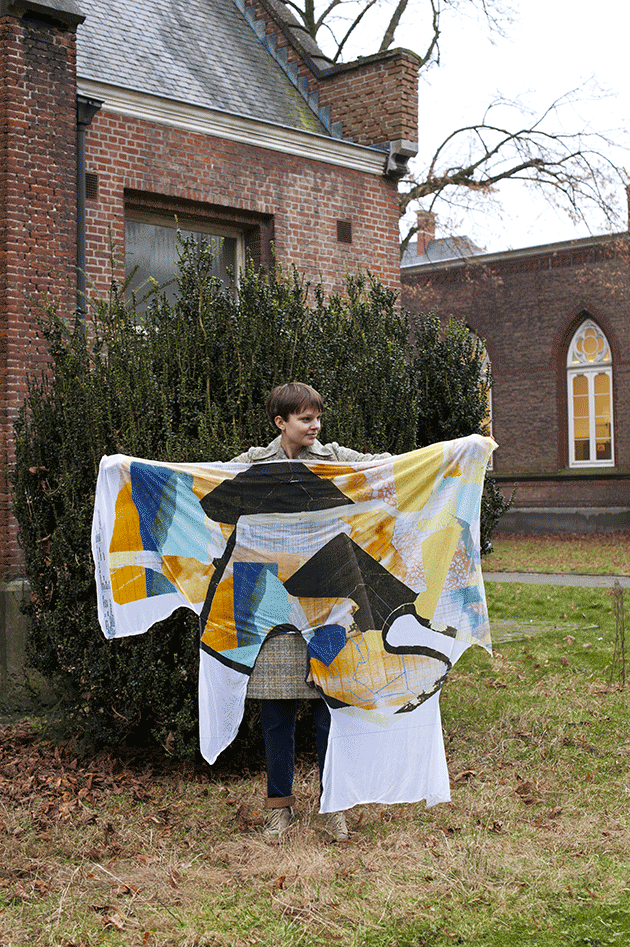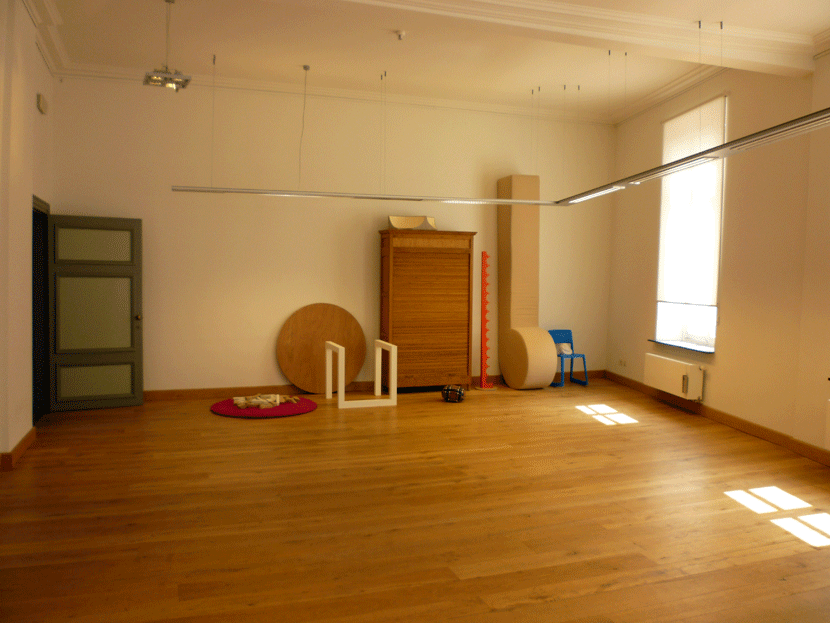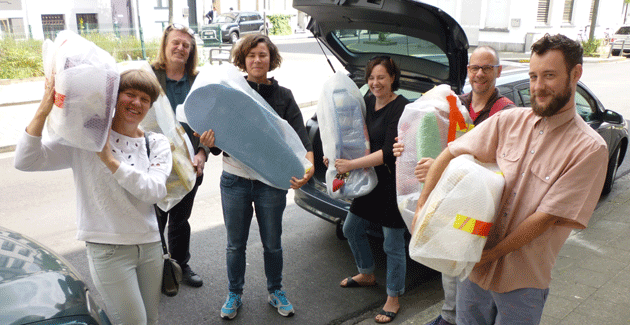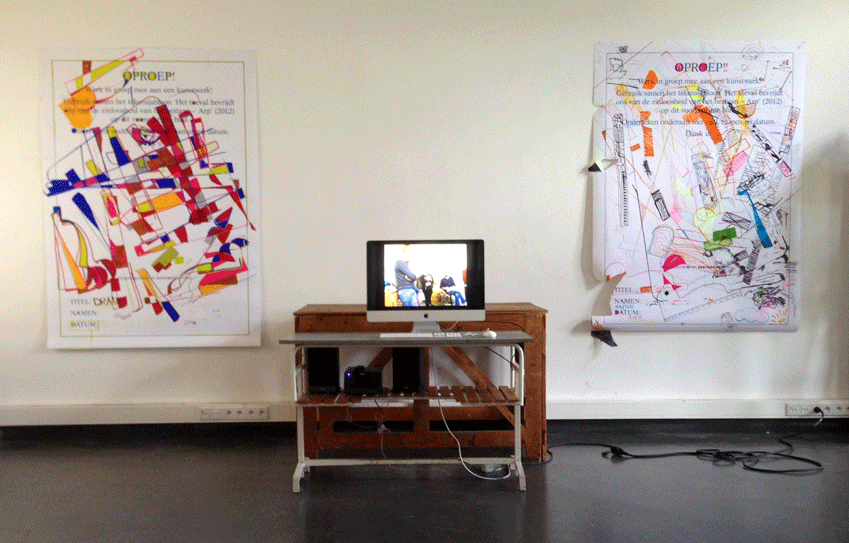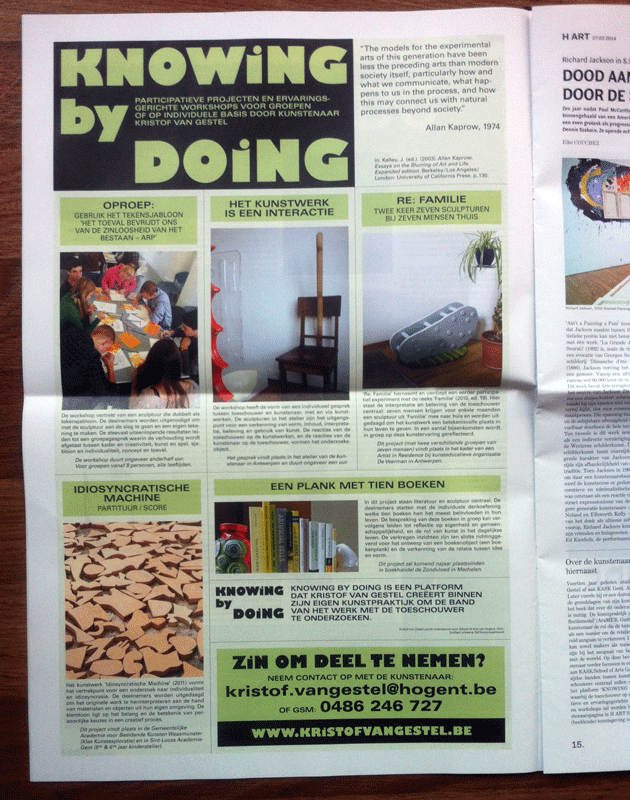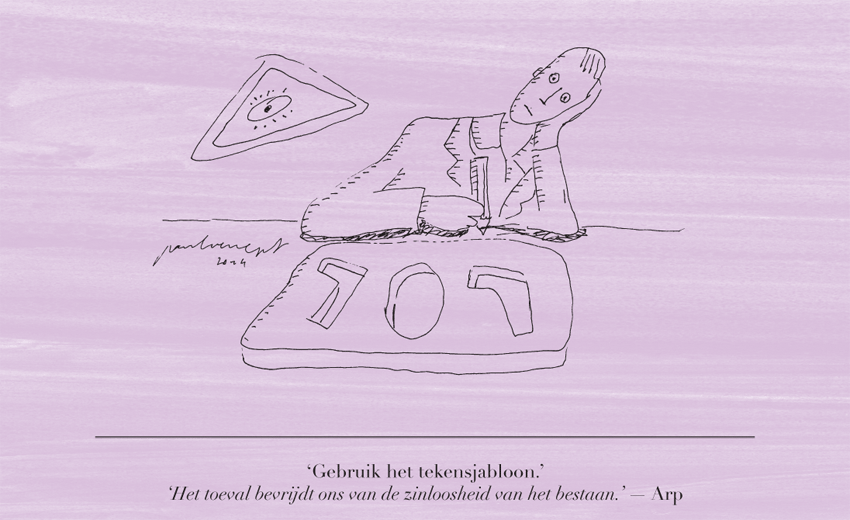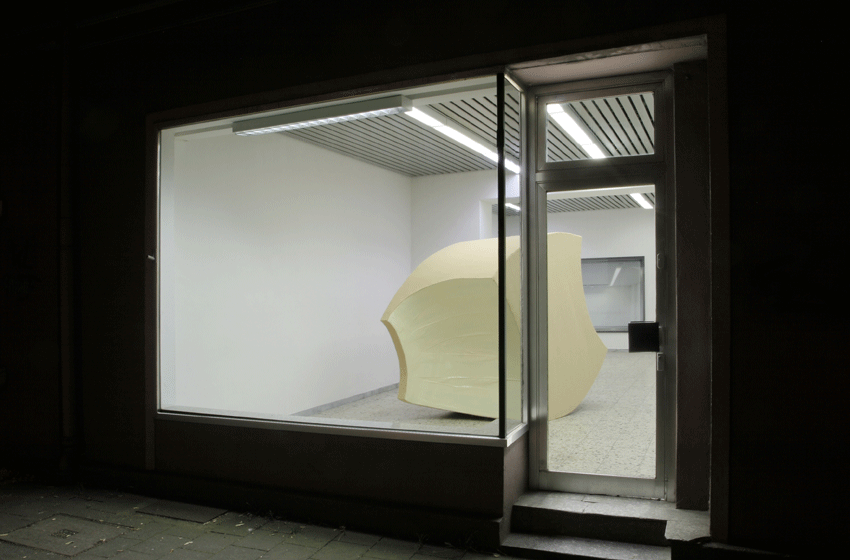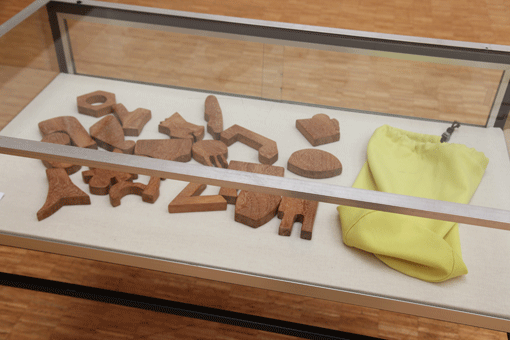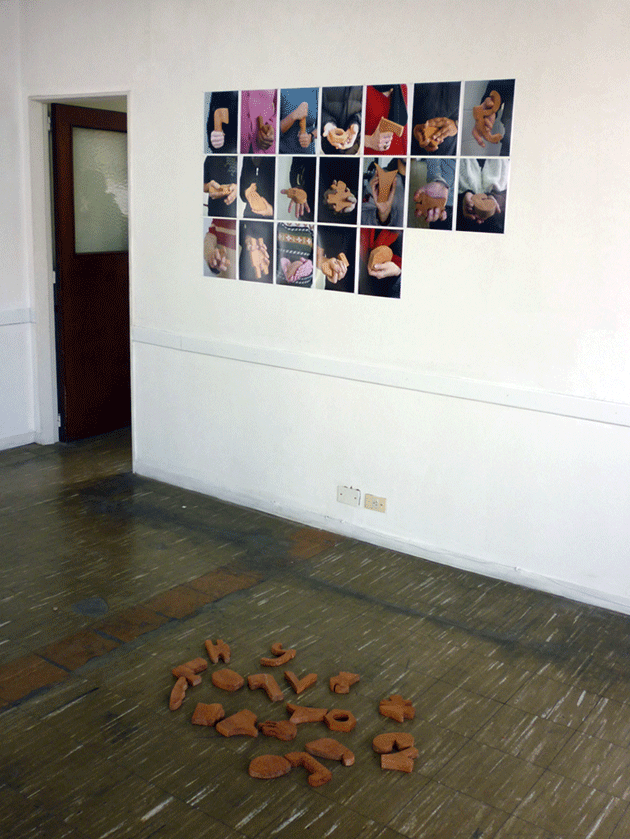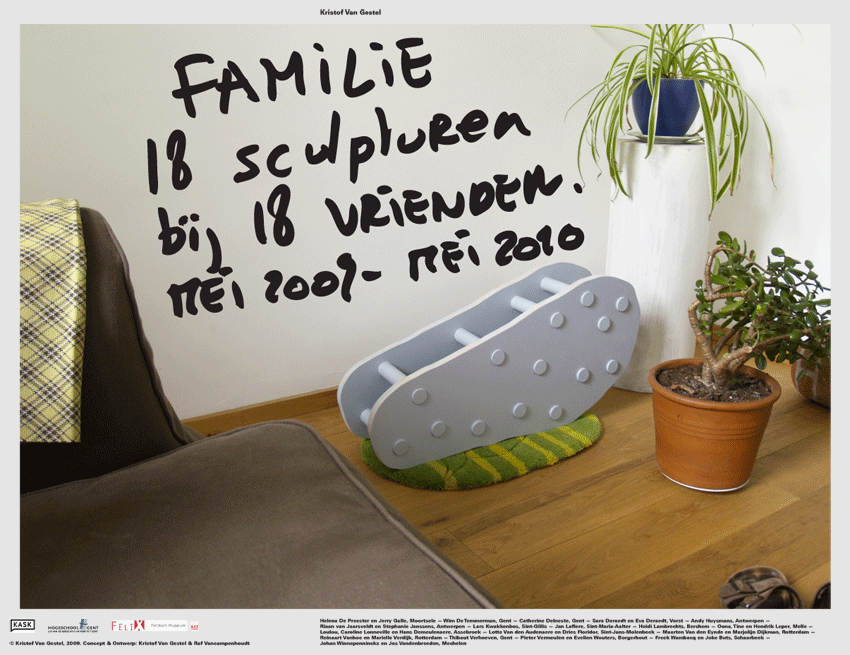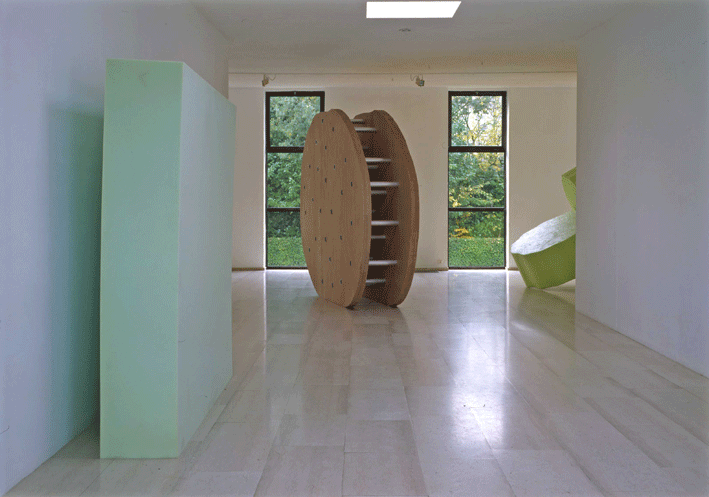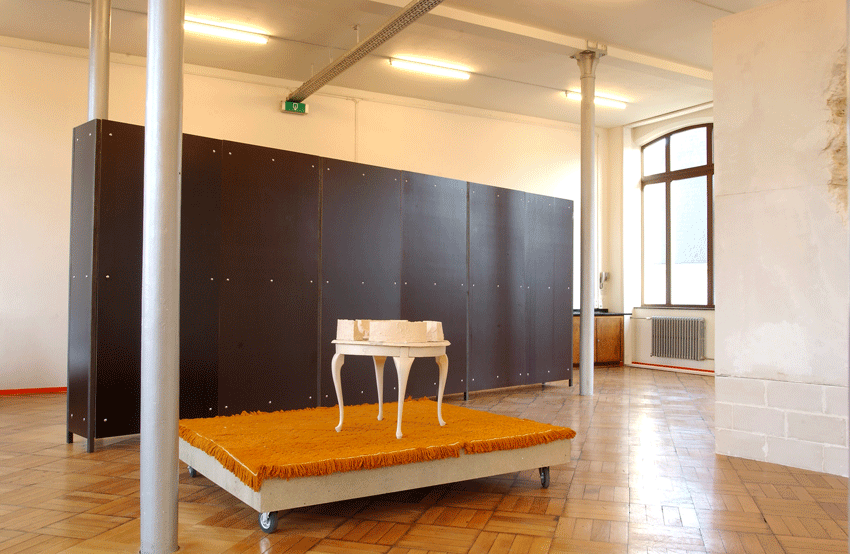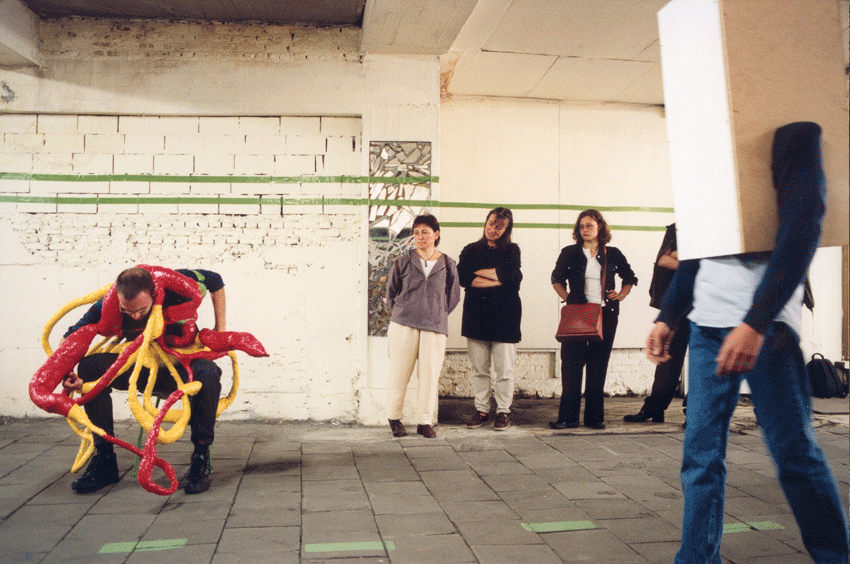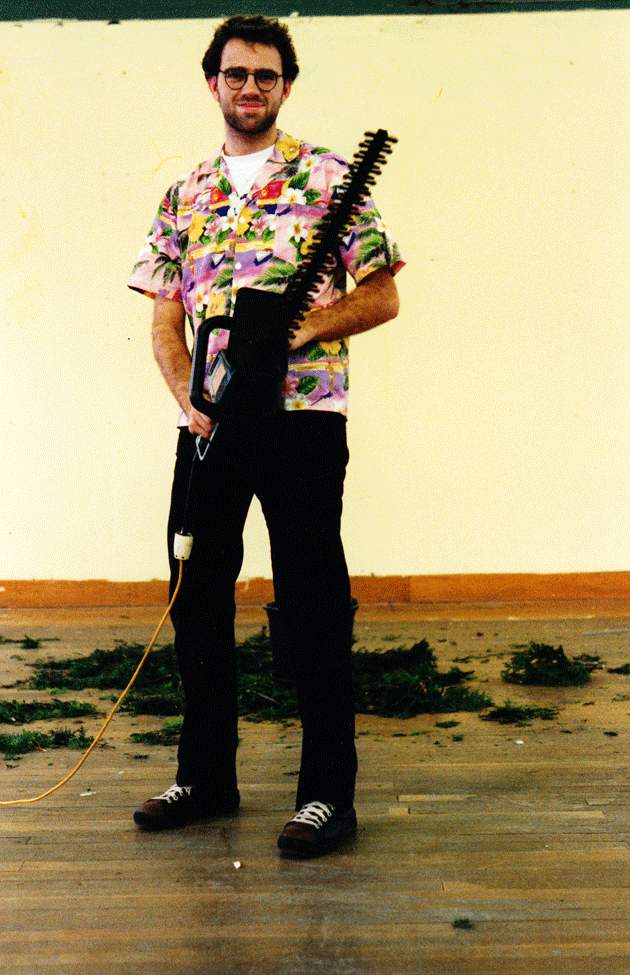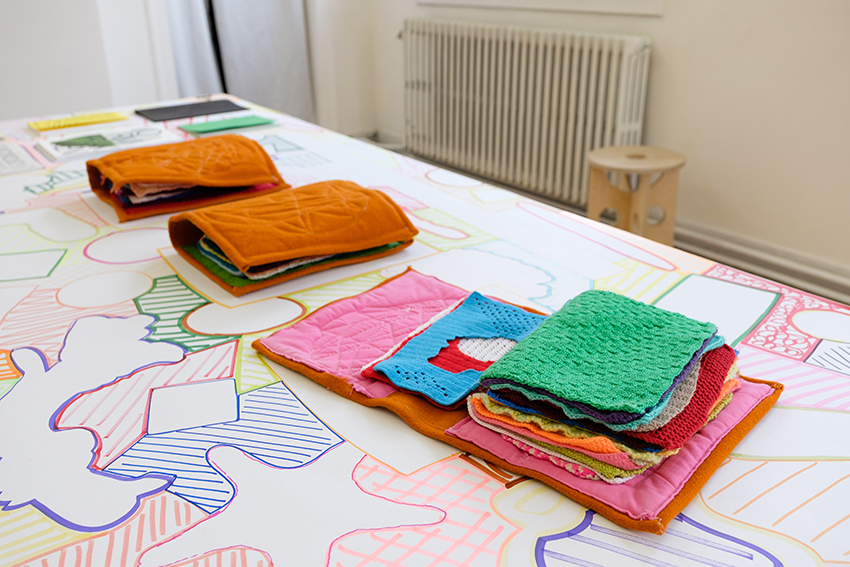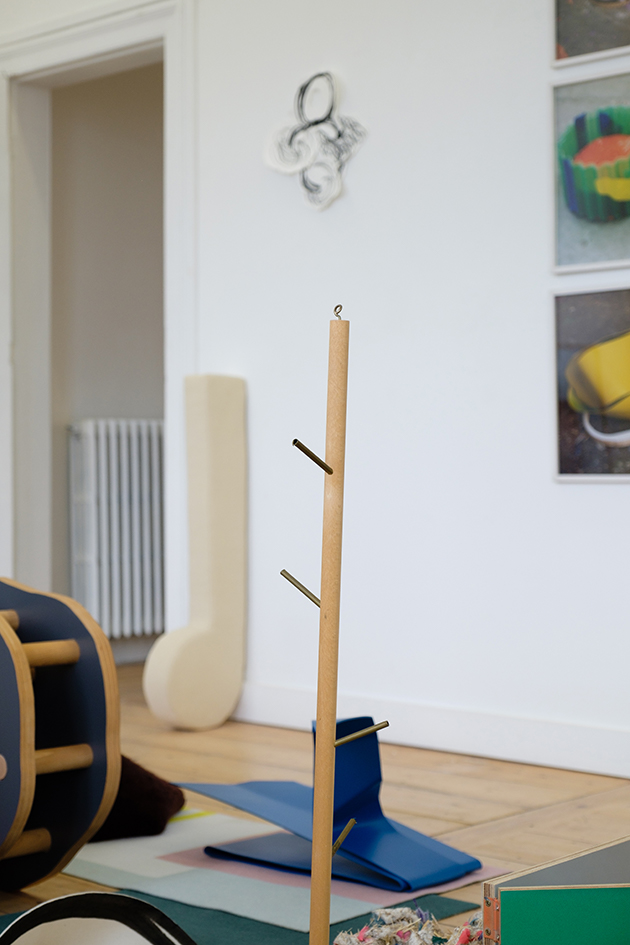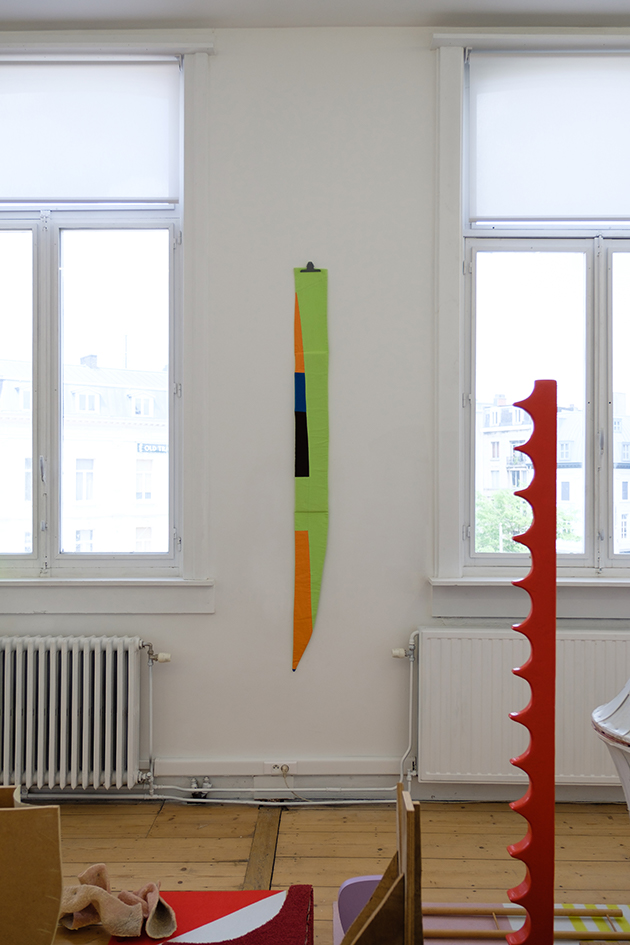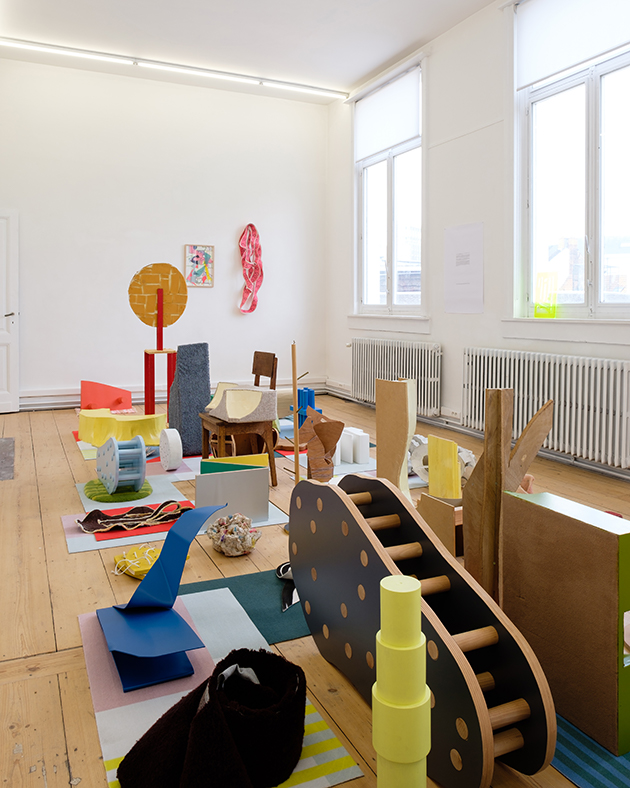
VOCABULARIUM I, II, III (2015)
Drie textiele vormenboeken door Manoeuvre ontstaan vanuit een vertaalfout van idiosyncratische vormen gemaakt met de vormengenererende tekenmethode Idiosyncratische Machine van Kristof Van Gestel. Manoeuvre: Caroline Camerlynck, Chris Rotsaert. Makerscollectief: Gul Atec, Zubeyde Bzamci, Rahime Koparan, Hediye Yigit Sahin, Sultan Altintas,Dürna Özgür, Gonül Atec, Gonül Altintas, Fadime Cetinkaya, Saniye Yuksel Göktepe, Hava Ucar, Hatice Gozukucuk, Hajer Ucar, Leila Hasjimi, Döne Kutlu, Griet Van den Broeck, Kevin Peeters, Ismahan Yildirim, Gulçeren Van Dort, Nacera Bendjafar, Nadya Varbanova, Marije Martini, Elitza Simeneova, Ludo Blommaert, Marleen Lievens. Manoeuvre is een kunstenaarscollectief voor ambacht en diversiteit, gevestigd in de Rabotwijk, Gent. De opbrengst van alle kunstproductie keert terug naar de makers van Manoeuvre.
Photography: Tomas Uyttendaele
NL
1. Bij het maken van een presentatie is er steeds de vraag naar de manier van tonen. Dingen die in het atelier of in het creatieproces zo vanzelfsprekend lijken voor de maker(s) hebben in een institutionele ruimte – om leesbaar te zijn voor de kijker – nood aan een vorm van display. In een gallerie is er bovendien de vraag of er wat verkocht kan worden.
Voor mij is het vinden van antwoorden op deze vragen – vanuit de proces- en ervaringsgerichtheid van mijn werk – niet altijd vanzelfsprekend. Daarnaast zijn er bij de participatieve projecten vaak meerdere auteurs of ingewikkelde (niet altijd duidelijk traceerbare) samenwerkingsverbanden. Dat dwingt om telkens – en zeker ook bij het bepalen van een prijs – de oefening te maken in auteurschap, eigenaarschap en statuut van het object.
Voor de presentatie Zinnen Maken bij mariondecannière wordt een stand van zaken getoond van twee grootschalige en wijdvertakte projecten binnen mijn praktijk: Vocabularium (sinds 2000) en Idiosyncratische Machine (sinds 2011). Met deze presentatie wil ik – zoals aangehaald – recht doen aan mijn praktijk als ervarings- en reflectieproces dat zich dicht bij de maker(s) ontwikkelt. Tegelijk wil ik toch de mogelijkheid onderzoeken voor anderen om in te stappen in dit proces of op hun beurt zelf een band op te bouwen met de producten die het genereert. Enerzijds als kijker maar zeker ook als deelnemer.
Deelnemen kan op verschillende manieren. Enerzijds door iets aan te kopen en met het object als een bijzondere (levende) speler om te gaan in de eigen leefruimte. Zo bijvoorbeeld een persoonlijke keuze uit zeefdrukken (Vormdrukkers, 2017), negentien houten vormen (ed. 7) als artefact of als opstartpakket en aanvulling bij Handleiding (2012) die samen de mogelijkheid bieden zelf aan de slag te gaan met de Idiosyncratische Machine (2011), Felix (2010) die voor deze presentatie als editie (ed. 5) wordt uitgegeven op tapijtjes gemaakt door Sarah Pattoor, Kribbel (2018), een zeefdruk/collage op papier (ed. 7), een Animatieboek (2017) of Vocabulaire: Drie Boeken (Manoeuvre, 2015) die beiden geactiveerd worden door er in te bladeren, … Anderzijds door zelf mee als co-auteur een werk te creëren, bijvoorbeeld in een zeefdrukworkshop voor een groep van max. vier deelnemers die ter gelegenheid van deze tentoonstelling samen met Gezeever als multiple wordt uitgegeven (Vormdrukkers/Zinnen Maken, ed. 5).
Kristof
* Ik dank ieder die de afgelopen jaren mijn werk mee mogelijk maakte. Ik dank u voor uw bezoek. Mogelijke kopers dank ik voor hun interesse en steun. Ik dank ook in het bijzonder Marion en Fred voor de uitnodiging en de hulp voor het opzetten van deze tentoonstelling. Dank aan Stefaan Vervoort voor het nalezen van deze teksten.
2. Vocabularium (sinds 2000) is een beeldbank met sculpturen, objecten, modellen, herinneringen en overblijfsels. Deze verzameling vormt de ruggegraat van het oeuvre dat ik ontwikkel.
De modellen in deze beeldbank ontstaan voornamelijk in het atelier op maat 1:1. Het zijn lijfelijke schetsen of haptische manifestaties. Aan de basis ligt een vorm van ‘écriture automatique’, die doorheen de jaren evolueert en op haar beurt ook weer geïnformeerd en beïnvloed wordt door de wendingen die het oeuvre neemt. Soms vertrekken de vormen als een idee of een impuls die voor het eerst schetsmatig gematerialiseerd wordt of als een restproduct van een afgeleid creatieproces waarop verder gewerkt wordt. Onderling communiceren ze als in een interreferentieel kader, een soort sculpturaal tekensysteem.
Een belangrijk associatief referentiekader bij het ontstaan van deze ruimtelijke vormen zijn dagdagelijkse gebruiksobjecten, maar ook de geschiedenis van sculptuur. De vormen zijn voor mij tools in een gesprek met zoveel reeds bestaande dingen. Steeds bevragen ze daardoor ook hun plaats, hun nut of hun functie in de wereld. Op die manier legt mijn Vocabularium een intersubjectieve ruimte bloot; een plaats voor dialoog tussen mij en talloze andere makers en gebruikers.
Meer dan vijftig vormen worden hier gepresenteerd als een miniatuuroverzicht van achttien jaar kunstenaarschap. Voornamelijk ben ik de auteur – aangevuld met opdrachten tot uitvoering (bijvoorbeeld aan Vera Vermeersch, Raf Van Campenhoudt, Ludo Gylens, Ian Gyselinck, Imatec, …) of vragen tot co-creatie (bijvoorbeeld met Jenka Van Hoecke, mijn moeder of co-creaties binnen het Zeefdrukatelier Gezeever of de onderzoeksgroep Performing Objects). Deze beeldbank fungeert voor mij als schetsboek, als atelier- en denkruimte vanwaaruit de beslissingen voor het oeuvre uitgezet en genomen worden. De strategieën die ik daarbij over de jaren vanuit deze denkbank articuleerde zijn talrijk: uniforme schaalvergrotingen op locatie, fotowerken van modellen als performers in bepaalde contexten, drukwerk, edities en – sinds 2010 – protocollen om samen met anderen aan de slag te gaan in participatieve projecten. Vormen krijgen vaak pas een titel als ze uit de beeldbank getild worden en in een andere context verschijnen.
*Deze verzameling wordt hier getoond op de tapijten Objects to place die door Leda Devoldere zijn ontworpen als onderdeel van het project Guidelines (2016). Voor deze presentatie zijn ze – als scenografie – aan de schaal van Vocabularium aangepast.
3. Bij de participatieve projecten komt het erop neer deelnemers mee te nemen in een werkproces gebaseerd op intuïtie, improvisatie, praktisch denken, materialiteit, toeval, abstractie, (rest)vorm, … Om tot participatie te komen ontwikkelde ik enkele creatiemodellen om binnen duidelijke kaders samen met anderen te ervaren, te creëren en te reflecteren. Een van deze protocollen – dat sinds 2011 groeide met medewerking van talloze deelnemers, kunstenaars, instituten, … – is de Idiosyncratische Machine. Deze ‘machine’ is een teken- en knipmethode waarbij deelnemers in groep in verschillende stappen het ontstaan van een gemeenschappelijke abstracte vormentaal ontdekken. Zo staat hier een vorm van intersubjectiviteit – en met name de ervaring van het onstaan daarvan – centraal.
In deze twee aaneengeschakelde ruimtes toon ik een aantal van de ‘restproducten’ van dit proces: zeefdrukken (2017) uit Vormdrukkers (sinds 2015) bij Gezeever (met Els Baeten, Tom Jespers, Sarah Patoor, Tijl Bossuyt, Sarah Ponet en Jasper Van Grunsven), boeken (Idiosyncratische Machine bij Croxhapox, Gent, Idiosyncratic Copymachine met Niek Pladet bij APE, Gent en Vormfrakken met/bij Manoeuvre, Gent), drie Animatieboeken (2017) samengesteld met restvellen van talloze workshops en voor deze presentatie van een display voorzien door Kris Kimpe, een workshop bij Gezeever als editie (Vormdrukkers/Zinnen Maken (2018), ed. 5 bij mariondecannière), Vocabulaire: Drie Boeken (2015) door/bij Manoeuvre, Gent en Bezem met stiftlijnrandjes (2017) als derivaat van Idiosyncratische Machine, S.M.A.K., Gent (2017).
De zeefdrukken en collages – alhoewel ze ontstonden in reeksen en onder gedeeld auteurschap – zijn individueel te koop. De inkomsten worden ingezet bij de verdere uitbouw en verspreiding van Idiosyncratische Machine als collectieve creatiemethode.
ENG
1. In creating a show there is always the matter of the way of presenting. Things that seem obvious to the creator in his studio or during the creation process require – in order to be readable to the spectator – a type of display. On top of that in the gallery there is the issue of salability.
For me, finding answers to these questions – with regards to the process and experience oriented nature of my practice – isn’t always evident. Furthermore, with participatory projects there are often multiple authors or complicated (not always easily traceable) collaberations involved. This forces one – especially when deciding on a price – to ask oneself questions about authorship, ownership and status of the object.
During the presentation Zinnen Maken (‘Making Sentences’) at mariondecannière, a status quo is on view of two large-scale and widely ramified projects within my practice: Vocabulary (since 2000) and Idiosyncratic Machine (since 2011). As mentioned before, with this presentation I want to do justice to the experiential and introspective effect my practice has on the creator(s). Nonetheless I still want to explore the possibility of others to enter a process or to create their own relation with the products it generates. On one side as a spectator but certainly as a participant as well.
Participating is possible in various ways. On the one hand by buying something and letting it interact with one’s personal space as a distinctive (living) player. Examples of this include a personal selection of silkscreen prints (Vormdrukkers, 2017); nineteen wooden shapes (ed. 7) as artefact or starter pack, that in addition to IM – Score (2012) will offer the possibility of starting an Idiosyncratice Machine (2011); Felix (2010), which will be issued as an edition (ed. 5) for this presentation; Kribbel (2018), a silkscreen print/collage on paper (ed. 7); an Animationbook (2017), or Vocabulary: Three Books (Manoeuvre, 2015), the last two of which can be activated by leafing through them, …
On the other hand by creating a work as a co-author, for example in a silkscreen printing workshop for a group of four people maximum that will be issued as an edition specifically for this exhibition (Vormdrukkers/Zinnen Maken, ed. 5).
Kristof
* I thank everyone who has made my work possible for the last years. I thank you for visiting. I thank potential buyers for their interest and support. I especially thank Marion and Fred for the invitation and the help setting up this exhibition. Thanks to Stefaan Vervoort for helping to edit this text and to Joachim Beens for translating it into English.
2. Vocabulary (since 2000) is an image archive with sculptures, objects, models, memories and remainders. This collection constitutes the backbone of the body of work I am developing.
The models in this archive originate mainly in the studio at scale 1:1. These are corporeal sketches or haptic manifestations. At the heart of these lies a type of ‘écriture automatique’ that evolves throughout the years and is in turn informed and influenced by the directions my oeuvre takes. Sometimes the forms start out as an idea or an impulse, sketchily materialized for a first time; or as a leftover of a derivative creation process that is still being worked on. Among each other, they communicate as in an interreferential framework, like a kind of sculptural sign system.
For the conception of these spatial shapes, important associative frames of reference are commonplace utensils, as well as the history of sculpture. To me these shapes are tools in a conversation with things already in existence. They therefore continuously question their place, use or function in the world. In this way, my Vocabulary exposes an intersubjective space; room for a dialogue between me and countless other makers and users.
More than fifty shapes are presented here like a miniature overview of eightteen years of artistic practice. Above all I am the author – complemented by commisions (by, among others, Vera Vermeersch, Raf Van Campenhoudt, Ludo Gylens, Ian Gyselinck, Imatec, …) or requests for co-authoring (for example with Jenka van Hoecke, my mother, or co-creations within the print screen studio Gezeever, or the research group Performing Objects). To me, this image archive functions as a sketchbook, as a work- and thinking space, from where decisions for the oeuvre are planned and executed. The strategies I have thereby articulated throughout the years are numerous: uniformly scaled enlargements on location, photographic works based on models as performers in a specific context, printed matter, editions, and – since 2010 – protocols to start working together with participants in participative projects. Shapes usually only get a title once they are taken from the archive and reappear in a different context.
*This collection is exhibited here on rugs titled Objects to place that were designed by Leda Devoldere as part of the project Guidelines (2016). As a scenography, for this presentation they were adapted to the scale of Vocabulary.
3. For the participative projects, it comes down to drawing participants into a working process that is based on intuition, improvisation, practical thinking, materiality, coincidence, abstraction, form, residual space, … To achieve participation, I have developed several models for creation to collectively, and within clear frameworks, experience, create and contemplate. One of these protocols – that has been developed since 2011 with the cooperation of numerous participants, artists, institutes, … – is the Idiosyncratic Machine. This ‘machine’ is a draw-and-cut procedure in which participants jointly and in various steps discover the creation of a common abstract language of shapes. In this way, a kind of intersubjectivity – and especially an experience of its creation – takes center stage.
In these two consecutive spaces I show a number of the ‘residual products’ of this process: silkscreen prints (2017) from Vormdrukkers (since 2015) by Gezeever (with Els Baeten, Tom Jespers, Sarah Patoor, Tijl Bossuyt, Sarah Ponet and Jasper Van Grunsven), books (Idiosyncratische Machine by Croxhapox, Ghent, Idiosyncratic Copymachine with Niek Pladet by APE, Ghent, and Vormfrakken with/by Manoeuvre, Ghent), three Animationbooks (2017) comprised of residual sheets from a number of workshops and provided with a display for this exhibition by Kris Kimp, a workshop at Gezeever as edition (Vormdrukkers/ Making Sentences (2018), ed. 5 at mariondecannière), Vocabulary: Three Books (2015) with/by Manoeuvre, Ghent, and Broom with marker line edges (2017) as derivative of Idiosyncratic Machine, S.M.A.K., Ghent (2017).
The silk screen prints – although generated in series and by multiple authors – are for sale individually. The profits will be used for further expansion and distribution of Idiosyncratic Machine as a collective mode of creation.



























